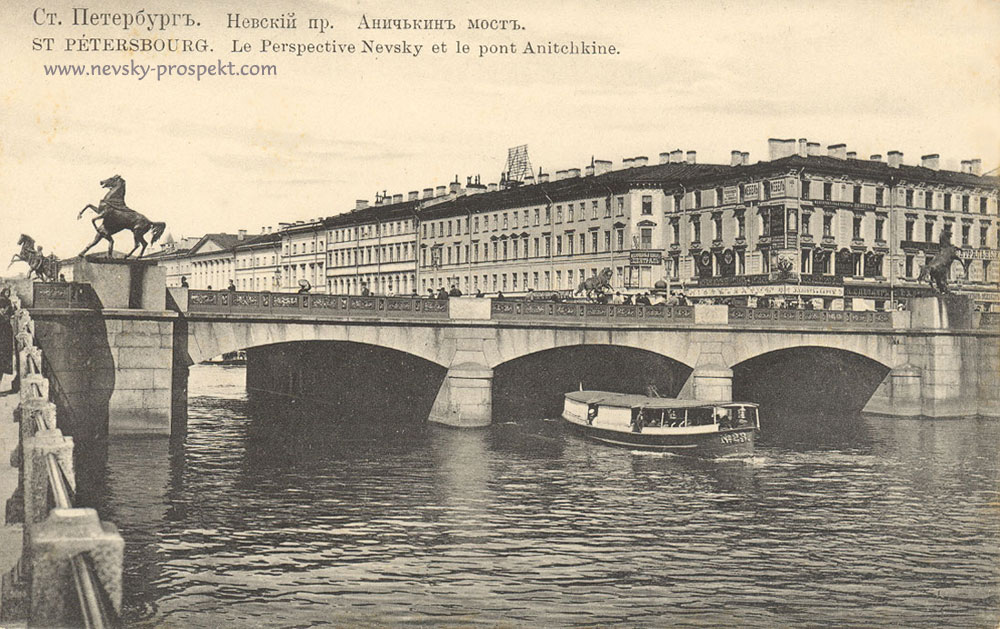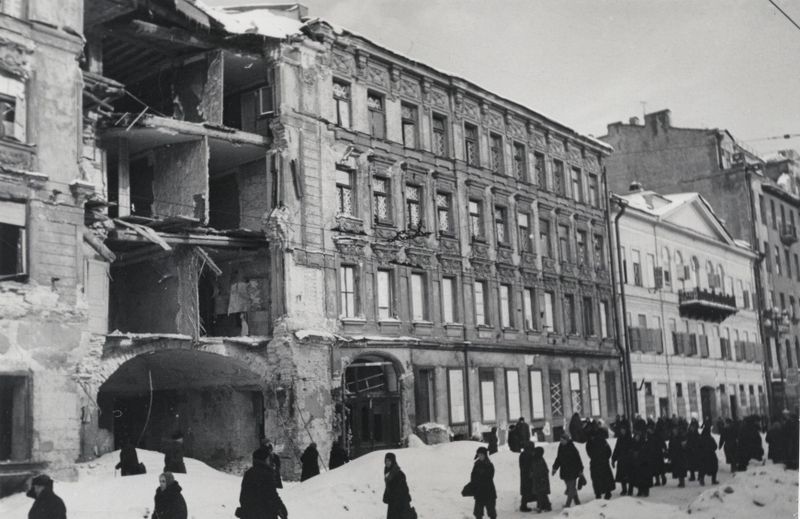
|
This vintage photo was taken c1903, in the days before the street was covered with a web of overhead cables for the trams and trolleybuses. The trams are long gone from the city's main street but the 'web' and trolleybuses remain. This image is particularly interesting because it shows on the extreme right, the old building number 68. On November 28th 1941, this building received a direct hit from a Nazi bomb and was so badly damaged the Nevsky facade had to be demolished. From 1874 until 1918 this was a high school and the city gymnasium No 12. Then in Soviet times the building was taken by the local government offices. It became the District Council’s Executive Committee and it stayed as the seat of the local Soviet government until the German bomb blitzed it. 
It took about three years from 1947 to 1950 for Soviet architects N. Zhuravlev and I. I. Thomin to design and complete a new Nevsky facing facade. The demolition job was so thorough that instead of restoring the building the authorities just built a new structure after the war. The end result was an unobtrusive, tactful Stalinist structure that fits well in its surroundings and creates no dissonance in the company of the historic buildings it found itself amongst
In the history of St. Petersburg this address is unofficially known as the Literary House or Literature House because of its rich literary heritage. V. N. Asenkova, the legendary Alexandrian Theatre’s actress lived here in 1837. A. A. Kraevsky, a journalist and publisher of Otecestvennye Zapiski (or Fatherland Notes) and of Literaturnaya Gazeta or Literary Newspaper, had an apartment in the building and worked here from 1830 until 1843. Literaturnaya Gazeta is still around and is one of oldest surviving names among Russian periodicals. From 1842 until 1846 Vissarion Belinsky, a writer and literary critic also lived at this address and freelanced for the Otecestvennye Zapiski in the same building. His apartment was a literary salon of sorts and Nikolai Nekrasov, I. Goncharov, Alexander Herzen, D. V. Grigorovich and Fyodor Dostoyevsky were frequent visitors. Here Belinsky met Dostoyevsky for the first time and supposedly told the young author that a great future awaits him. Ivan Turgenev lived here from 1850 until 1851. Novaya Zhizn’, a Bolshevik newspaper was published here in 1905. The first meeting of Vladimir Lenin and Alexeï Gorki took place at this address in the Bolshevist newspaper’s editorial office. At the turn of the century one of the inner buildings held offices of Stroitel or Builder, a company that specialized in manufacture of construction materials and cement. In the inner courtyard was an exhibition space where regular shows were held. The first exhibition of Futurists took place at this address. A fashionable cinema Folies-Bergère was also located here before the First World War as well as I. D. Sytin’s bookstore. The Nevsky facing (Stalinist)
building is now the “home” of the Leningrad District
Tax Inspectorate, whilst side and inner buildings have several
retail establishments, offices and apartments.
That last entry can now be consigned to the archives of history as
the 19th-century Literary House at 68 Nevsky Prospekt was demolished
in February 2011 because the city's planning office decided that Spb really
needed a new modern hotel at this precise location. Anichkov BridgeThe Anichkov Bridge (Anichkov Most), was the first and most famous bridge across the Fontanka River in St. Petersburg. The current bridge, built in 1841-42 and reconstructed in 1906-08, combines a simple form with some spectacular decorations. As well as its four famous horse sculptures designed by the Russian sculptor, Baron Peter Klodt (1849-50), the bridge has some of the most celebrated ornate iron railings in the city. The structure is mentioned in the works of Pushkin, Gogol, and Dostoevsky. In 1941, during the Second World War, when the bridge came under heavy fire from German artillery, the sculptures were removed from their platforms and buried in the nearby Anichkov Palace garden. The bridge suffered serious damage during the war, but was fully restored shortly after the war ended. As a memorial, the pedestal of one of the statues retains the effects of artillery fire, with a plaque explaining this to passers-by. Prior to the tercentenary of Saint Petersburg, the statues were removed from the bridge again and underwent thorough restoration. This was the third restoration of Klodt’s horses: the first was before the First World War, and the second in the mid-1970s but on this last occasion restorers were surprised to find secret trap-doors on the back of each horse. The restorers not only saved the sculptures but also conserved them for the future. St. Petersburg scientists, in collaboration with a group of experienced restorers, were the first to use a new method of making a protective and decorative covering for monuments. With the aid of the latest technologies they applied an unnoticeable layer on to the bronze compositions, very similar in its properties to natural patina, which will serve as a long durable protection for the monuments.
|
Copyright © 2000-2017
Email Contact : [email protected]
